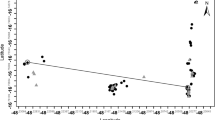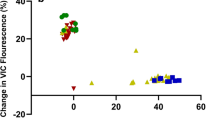Abstract
Biparental inheritance of plastids has been documented in numerous angiosperm species. The adaptive significance of the mode of plastid inheritance (unior biparental) is poorly understood. In plants exhibiting paternal inheritance of plastids, DNA-containing plastids in the microgametophyte may affect survival or growth of the gametophyte or the embryo. In this study the number of plastids containing DNA (nucleoids) in generative cells and generative cell and pollen volumes were evaluated in a range of genotypes of Medicago sativa (alfalfa). M. sativa exhibits biparental inheritance of plastids with strong paternal bias. The M. sativa genotypes used were crossed as male parents to a common genotype and the relationships between the gametophytic traits measured and male reproductive success were assessed. Generative cell plastid number and pollen grain size exhibited opposing associations with male fertility. Path analysis showed that generative cell plastid number was negatively associated with male fertility. This study provides evidence that there may be a competitive advantage at fertilization afforded sperm that have minimized their organelle content. The apparent lack of strong selection for reduced plastid number in generative cells of M. sativa may be a reflection of the diminished importance of reproductive success due to its perenniality or its long use in cultivation.
Similar content being viewed by others
References
Barnes DK, Bingham ET, Murphy RP, Hunt OJ, Beard DF, Skrdla WH, Teuber LR (1977) Alfalfa germplasm in the United States: genetic vulnerability, use, improvement, and maintenance. US Dep Agric Tech Bull 1571
Corriveau JL, Coleman AW (1988) Rapid screening method to detect potential biparental inheritance of plastid DNA and results for over 200 angiosperm species. Am J Bot 75:1443–1458
Corriveau JL, Coleman AW (1991) Monitoring by epifluorescence microscopy of organelle DNA fate during pollen development in five angiosperm species. Dev Biol 147:271–280
Cruzan MB (1990) Variation in pollen size, fertilization ability, and postfertilization siring ability in Erythronium grandiflorum. Evolution 44:843–856
Harris SA, Ingram R (1991) Chloroplast DNA and biosystematics: the effects of intraspecific diversity and plastid transmission. Taxon 40:393–412
Keys RN, Smith SE, Mogensen HL, Small E (1995) Microgametophytic plastid nucleoid content and life history traits of tribe Trifolieae (Fabaceae). Plant Syst Evol 196 (1/2)
Kirk JTO, Tilney-Bassett RAE (1978) The plastids, 2nd edn. Elsevier/North Holland, Amsterdam
Rumbaugh MD, Caddell JL, Rowe DE (1988) Breeding and quantitative genetics. In: Hanson AA, Barnes DK, Hill RR Jr (eds) Alfalfa and alfalfa improvement. American Society of Agronomy, Madison, Wis, pp 777–808
SAS Institute, Inc (1985) SAS/STAT guide for personal computers: version 6. SAS Institute, Cary, NC
Sayers ER, Murphy RP (1966) Seed set in alfalfa as related to pollen tube growth, fertilization frequency, and post-fertilization ovule abortion. Crop Sci 6:365–368
Schumann CM, Hancock JF (1989) Paternal inheritance of plastids in Medicago saliva. Theor Appl Genet 78:862–866
Shi L, Zhu T, Mogensen HL, Smith SE (1991) Paternal plastid inheritance in alfalfa: plastid nucleoid number within generative cells correlates poorly with plastid number and male plastid transmission strength. Curr Genet 19:399–401
Smith SE (1989a) Biparental inheritance of organelles and its implications in crop improvement. Plant Breed Rev 6:361–393
Smith SE (1989b) Influence of parental genotype on plastid inheritance in Medicago sativa. J Hered 80:214–217
Smith SE, Bingham ET, Fulton RW (1986) Transmission of chlorophyll deficiencies in Medicago sativa. Evidence for biparental inheritance of plastids. J Hered 77:35–38
Smith SE, Conta DM, Bechert U (1990) Pollen load, seed position, and agronomic performance in alfalfa. Crop Sci 30:561–565
Sokal RR, Rohlf FJ (1981) Biometry. Freeman, New York
Wiens D (1984) Ovule survivorship, brood size, life history, breeding systems, and reproductive success in plants. Oecologia 64:47–53
Willson ME, Burley N (1983) Mate choice in plants. Tactics, mechanisms, and consequences. Princeton University Press, Princeton, NJ
Zhu T, Mogensen HL, Smith SE (1991) Quantitative cytology of the alfalfa generative cell and its relation to male plastid inheritance patterns in three genotypes. Theor Appl Genet 81:21–26
Zhu T, Mogensen HL, Smith SE (1993) Quantitative, three-dimensional analysis of alfalfa egg cells in two genotypes: implications for biparental plastid inheritance. Planta 190:143–150
Author information
Authors and Affiliations
Rights and permissions
About this article
Cite this article
Keys, R.N., Smith, S.E. & Mogensen, H.L. Variation in generative cell plastid nucleoids and male fertility in Medicago sativa . Sexual Plant Reprod 8, 308–312 (1995). https://doi.org/10.1007/BF00229388
Received:
Accepted:
Issue Date:
DOI: https://doi.org/10.1007/BF00229388




